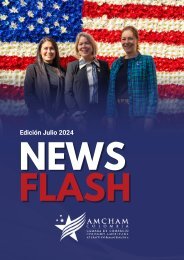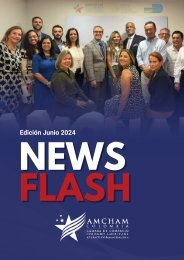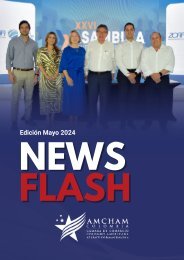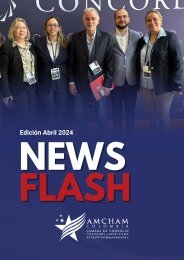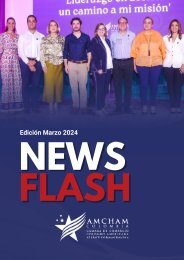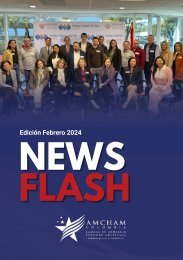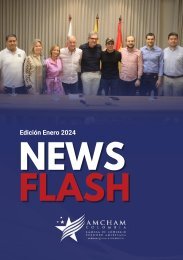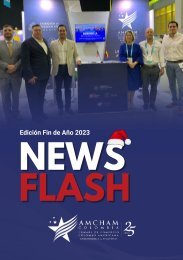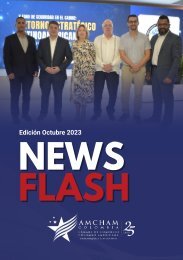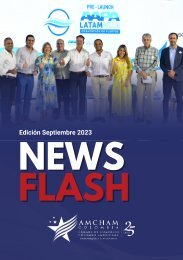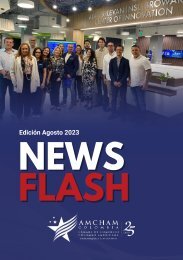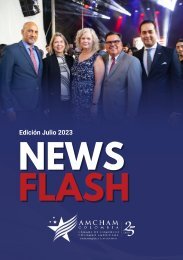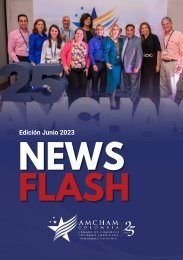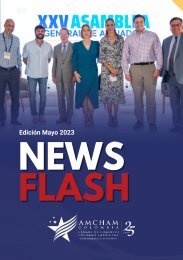City Report: Barranquilla - Global Miami Magazine
Create successful ePaper yourself
Turn your PDF publications into a flip-book with our unique Google optimized e-Paper software.
<strong>City</strong> <strong>Report</strong>:<br />
<strong>Barranquilla</strong><br />
COLOMBIA’S “GOLDEN GATE” BECKONS FOR BUSINESS WITH U.S. NEARSHORING,<br />
CALL CENTERS, AND INVESTMENT<br />
Sponsored by AMCHAM <strong>Barranquilla</strong><br />
Atlantic Quantum Innovations • The Caribbean Health Group • Florida International Tax Advisors<br />
LATAM • King Ocean • Lean Solutions Group • MIA • Pay Cargo<br />
Port Everglades • Port <strong>Miami</strong> • Seaboard Marine • Tecnoglass • Winston & Strawn LLP
Designed for Life<br />
Luxury windows and and doors built to to the the highest<br />
specifications to to meet your your exceptional standards.<br />
www.eswindows.com<br />
2 GLOBALMIAMIMAGAZINE.COM
3
SPECIAL REPORT<br />
TABLE OF CONTENTS<br />
SPECIAL REPORT<br />
8<br />
CITY REPORT:<br />
BARRANQUILLA<br />
Colombia’s fourth-largest metro area by<br />
population, the port city of <strong>Barranquilla</strong><br />
is now building a reputation as a hub<br />
for “nearshoring,” both in manufacturing<br />
for U.S. sales and in call centers for<br />
U.S. clients.<br />
22<br />
THE NEW OFFSHORING<br />
How furniture maker Kannoa moved<br />
production from China to <strong>Barranquilla</strong>,<br />
employing about 130 people in Colombia<br />
and 40 in <strong>Miami</strong>.<br />
24<br />
GOING BILINGUAL<br />
Call center company Atlantic Quantum<br />
Innovation is building a new<br />
facility to boost employment to 4,500.<br />
26<br />
MOVING TO MIAMI<br />
Why <strong>Barranquilla</strong> companies like<br />
Finotex and Procaps are investing in<br />
South Florida.<br />
28<br />
CELEBRATE ON<br />
<strong>Barranquilla</strong>’s pre-Lenten Carnival<br />
shines as Colombia’s largest cultural<br />
extravaganza.<br />
30<br />
SNAPSHOTS<br />
Four international stars from the<br />
Colombian city live or have lived in<br />
Greater <strong>Miami</strong>.<br />
49<br />
60<br />
62<br />
64<br />
66<br />
68<br />
PUBLISHER<br />
Richard Roffman<br />
EDITOR-IN-CHIEF<br />
J.P. Faber<br />
ASSOCIATE PUBLISHER<br />
Gail Feldman<br />
SENIOR VP INTERNATIONAL<br />
Manny Mencia<br />
DIRECTOR OF OPERATIONS<br />
Monica Del Carpio-Raucci<br />
SALES AND PARTNERSHIPS<br />
Sherry Adams<br />
Amy Donner<br />
Andrew Kardonski<br />
Gail Scott<br />
MANAGING EDITOR<br />
Kylie Wang<br />
ASSOCIATE EDITOR<br />
Yousra Benkirane<br />
WRITER<br />
Doreen Hemlock<br />
ART DIRECTOR<br />
Jon Braeley<br />
PHOTOGRAPHERS<br />
Rodolfo Benitez<br />
PRODUCTION DIRECTOR<br />
Toni Kirkland<br />
CIRCULATION & DISTRIBUTION<br />
CircIntel<br />
BOARD OF ADVISORS<br />
Ivan Barrios, World Trade Center <strong>Miami</strong><br />
Ralph Cutié, <strong>Miami</strong> International Airport<br />
Roberto Munoz, The <strong>Global</strong> Financial Group<br />
Gary Goldfarb, Interport<br />
Bill Johnson, Strategic Economic Forum<br />
David Schwartz, FIBA<br />
EDITORIAL BOARD<br />
Alice Ancona, World Trade Center <strong>Miami</strong><br />
Greg Chin, <strong>Miami</strong> International Airport<br />
Paul Griebel, Venture for America<br />
James Kohnstamm, Beacon Council<br />
John Price, Americas Market Intelligence<br />
Tiffany Comprés, FisherBroyles<br />
TJ Villamil, Enterprise Florida<br />
<strong>Global</strong> <strong>Miami</strong> <strong>Magazine</strong> is published monthly by<br />
<strong>Global</strong> Cities Media, LLC. 1200 Anastasia Ave.,<br />
Suite 217, Coral Gables, FL 33134. Telephone:<br />
(305) 452-0501. Copyright 2023 by <strong>Global</strong> Cities<br />
Media. All rights reserved. Reproduction in whole or<br />
part of any text, photograph, or illustration without<br />
prior written permission from the publisher is strictly<br />
prohibited. Send address changes to subscriptions@<br />
globalmiamimagazine.com. General mailbox email<br />
and letters to editor@globalmiamimagazine.com<br />
6 GLOBALMIAMIMAGAZINE.COM
BRINGING YOU CLOSER TO YOUR<br />
CUSTOMERS FOR 40 YEARS<br />
NORTH AMERICA CARIBBEAN CENTRAL AMERICA SOUTH AMERICA<br />
In today’s fast-paced market, the only way to close the gap with your trading partners is to improve the<br />
supply chain. To do this, you will need a group of dedicated, hardworking professionals with 40 years of<br />
experience in logistics and ocean transportation. You will need more than just excellent customer service.<br />
You will want to work with a company striving to be better and more innovative. At Seaboard Marine, your<br />
customers are closer because our customers are at the center of everything we do.<br />
www.seaboardmarine.com
SPECIAL REPORT<br />
<strong>City</strong> <strong>Report</strong>:<br />
<strong>Barranquilla</strong><br />
MANUFACTURING, NEARSHORING, CALL CENTERS, AND INVESTMENT<br />
TECNOGLASS IS THE<br />
LARGEST MANUFACTURER<br />
IN BARRANQUILLA, MAKING<br />
SPECIALTY WINDOWS USED<br />
IN HIGH-RISES ACROSS<br />
LATIN AMERICA, THE U.S.,<br />
AND FLORIDA, INCLUDING<br />
MIAMI’S BRICKELL CITY<br />
CENTRE AND RELATED<br />
GROUP’S PROJECTS.<br />
8
BY DOREEN HEMLOCK<br />
What’s most important is people.<br />
Everyone in Tecnoglass has my personal<br />
phone number and email.<br />
CHRISTIAN DAES, ABOVE, COO OF TECNOGLASS<br />
<strong>Barranquilla</strong>, Colombia – This tropical city off the Caribbean coast is best<br />
known overseas for its cultural and sports treasures: its festive Carnival, singer<br />
Shakira, actress Sofia Vergara, fashion designer Silvia Tcherassi, and baseball<br />
great Edgar Renteria, to name a few.<br />
Now, the port city is building a reputation as a hub for “nearshoring,” both in<br />
manufacturing for U.S. sales and in call centers for U.S. clients. It’s also emerging as<br />
a model for sustainability. Its public parks program just won a global prize, chosen<br />
among entries from 155 cities. And it’s the first area in Colombia rolling out English<br />
studies in all public middle and high schools, aiming to ensure the language skills for<br />
long-term business with its top trade partner, the United States.<br />
Colombia’s fourth-largest metro area by population, <strong>Barranquilla</strong> is leveraging<br />
its location as the country’s biggest city close to the U.S. It’s just 2.5 hours by air from<br />
<strong>Miami</strong>, a flight shorter than the <strong>Miami</strong>-New York route. Executives from Florida<br />
can fly in and out the same day. And <strong>Barranquilla</strong> is just three to four days by ship<br />
9
SPECIAL REPORT<br />
USA<br />
<strong>Miami</strong><br />
<strong>Barranquilla</strong><br />
Cartagena<br />
Santa Marta<br />
Medellin<br />
Bogota<br />
COLOMBIA<br />
<strong>Barranquilla</strong> at a Glance<br />
Population: 1.2 million in the city proper and<br />
2.7 million in the Atlantico Department (state).<br />
Ranking: Capital of Atlantico Department and<br />
Colombia’s fourth-most populous city.<br />
Economy: Manufacturing and port activities,<br />
with 25-plus industrial parks and four<br />
free-trade zones; growing tourism. Atlantico<br />
represents about 4 percent of Colombia’s<br />
economy and 5 percent of its population.<br />
Economic Growth: About 4 percent yearly<br />
over the past decade, faster than Colombia’s<br />
national average, thanks largely to closer<br />
collaboration between the public and private<br />
sectors.<br />
Trade: Exports of $2.4 billion in 2022, with the<br />
U.S. as its top trade partner.<br />
Links to South Florida: Daily flights to <strong>Miami</strong><br />
and Fort Lauderdale that take about 2.5 hours;<br />
at least twice a week shipping service to<br />
South Florida, with freight arriving in as little<br />
as three days.<br />
Source: Pro<strong>Barranquilla</strong> agency; AmCham <strong>Barranquilla</strong>.<br />
Our orientation as a port city is international.<br />
We see the United States as our natural partner<br />
and Florida as our primary gateway to the U.S.<br />
VICKY IBAÑEZ, SHOWN RIGHT, EXECUTIVE DIRECTOR OF<br />
AMCHAM-BARRANQUILLA<br />
from South Florida, with freight costs now as low as $1,600 for a<br />
40-foot container, cheaper than many transits within Colombia or<br />
the U.S. itself.<br />
“Our orientation as a port city is international. We see the<br />
United States as our natural partner and Florida as our primary<br />
gateway to the U.S.,” says Vicky Ibañez, executive director of Am-<br />
Cham <strong>Barranquilla</strong>, the largest American Chamber of Commerce<br />
in Colombia relative to city size.<br />
BUILDING ON ITS HISTORY AS COLOMBIA’S “GOLDEN GATE”<br />
<strong>Barranquilla</strong>’s location by the Caribbean and proximity to Florida has<br />
long been key to its development. In the early 1900s, especially around<br />
World War II, its seaport welcomed diverse immigrants, including<br />
Jews from Europe and Middle Easterners, both Christian and Muslim.<br />
That influx prompted its nickname, “Colombia’s Golden Gate,”<br />
and explains why Middle Eastern food is now considered “local”<br />
cuisine.<br />
10 GLOBALMIAMIMAGAZINE.COM
SPECIAL REPORT<br />
The city also was the launchpad for Colombian aviation. The<br />
airline that became Avianca, Colombia’s flag carrier, began in<br />
<strong>Barranquilla</strong> in 1919, making it the world’s second-oldest, after the<br />
Netherlands’ KLM. Initial flights from the airport, named Ernesto<br />
Cortissoz for an Avianca president, headed to South Florida.<br />
When Colombia started free trade-zones to encourage exports,<br />
<strong>Barranquilla</strong> opened the first one – back in 1958. That zone now<br />
hosts some 70 companies, most selling to the U.S.<br />
Still, it’s only been in the past 16 years that <strong>Barranquilla</strong> has<br />
shaken off its late 20th century doldrums to again shine among Colombia’s<br />
dynamos. The spark came from a group of visionary mayors<br />
led by Alex Char, the son of a wealthy family that owns Colombia’s<br />
Olimpica supermarkets and other businesses. Char was elected in<br />
2007, pledging to forge a public-private partnership and tackle such<br />
pressing problems as severe flooding after rains. He delivered, even<br />
installing underground pipes to channel rainwater. Barred from consecutive<br />
terms, he was re-elected in 2015 and just won re-election for<br />
another four-year term starting in January. Peers from his group have<br />
won in between, providing continuity in policy and laying out a city<br />
plan through 2100, with an emphasis on international business.<br />
“The most important change in these 16 years is our mentality.<br />
Now, we think big and long-term,” says Lelio Sotomonte, who runs<br />
the city’s biggest call center, Atlantic Quantum Innovation, which<br />
serves many U.S. clients. “We’re reclaiming our role as Colombia’s<br />
Golden Gate.”<br />
TECNOGLASS: BARRANQUILLA’S LARGEST MANUFACTURER<br />
The clearest example of <strong>Barranquilla</strong>’s U.S. export success is Tecnoglass,<br />
a company founded by a family of Middle Eastern heritage. It is now<br />
LELIO SOTOMONTE, ATLANTIC QUANTUM INNOVATION<br />
TECNOGLASS’ MONUMENT VENTANA AL MUNDO (WINDOW TO THE WORLD)<br />
listed on the New York Stock Exchange and will soon reach $1 billion<br />
in sales. The company makes specialty windows used in numerous<br />
high-rises across Florida and the U.S., including <strong>Miami</strong>’s Brickell <strong>City</strong><br />
Centre, One Thousand Museum Tower, and Related Group’s projects.<br />
Tecnoglass started out in 1983 producing solar water heaters<br />
for Colombian homes but pivoted with changing market conditions.<br />
In the 1990s, it began exporting specialty glass to <strong>Miami</strong>, and in<br />
the 2000s, started selling its specialty windows in South Florida. In<br />
the 2010s, it listed its stock on Wall Street, first on the NASDAQ<br />
exchange. Last year, it posted sales topping $716 million, almost all<br />
in the U.S., from <strong>Miami</strong> to Chicago and as far west as San Francisco,<br />
says chief operating officer Christian Daes.<br />
“We went public on Wall Street not for money, but for credibility.<br />
Outside <strong>Miami</strong>, when we’d say we’re from Colombia, we’d<br />
often get questions like: ‘Where is Colombia? What can I do if<br />
there’s no delivery?,’” Daes says. “After listing, we could say, ‘Look at<br />
our stock ticker and reports. We’re for real.’ “<br />
Tecnoglass now employs more than 9,000 people in <strong>Barranquilla</strong>,<br />
making up to 3,000 custom windows daily and even<br />
mobilizing robots for inventory control. To keep exports growing,<br />
the company just moved its global headquarters to <strong>Miami</strong>. Daes<br />
commutes regularly from Florida to the <strong>Barranquilla</strong> factories, as he<br />
also develops a large <strong>Miami</strong> area showroom to serve U.S. clients.<br />
Beyond exports, Tecnoglass stands out in <strong>Barranquilla</strong> for the<br />
city monuments that it has donated and maintains. In the past five<br />
years, it’s unveiled the colorful Ventana Al Mundo (Window to the<br />
World), often shown on TV as the city’s icon and rising some 15<br />
stories; and Ventana de Campeones (Window of Champions), a<br />
landmark often called “Shark Fin” that stands about 10-floors high.<br />
Daes calls the landmarks part of his company’s “social respon-<br />
12 GLOBALMIAMIMAGAZINE.COM
Cruise Capital of the World<br />
<strong>Global</strong> Gateway of the Americas<br />
CRUISE & CARGO<br />
WORKING TOGETHER<br />
13
SPECIAL REPORT<br />
ABOVE: BARRANQUILLA IS LOCATED ON MAGDALENA RIVER, WITH ACCESS TO THE CARIBBEAN SEA<br />
ABOVE RIGHT: MARCELA BARRIOS, VP OF THE BARRANQUILLA FREE ZONE<br />
“Nearshoring is not just for companies, but for the people who<br />
come to do business here,” says Barrios. “We’re a city with Germans,<br />
Americans, Middle Easterners, and a multiplicity of cultures and<br />
cuisines that make newcomers feel welcome.”<br />
Also vital for nearshoring: strong sea and air links. <strong>Barranquilla</strong>’s<br />
main seaport has been investing and diversifying its services<br />
to grow. Since 2021, the Port of <strong>Barranquilla</strong> has been owned by<br />
<strong>Miami</strong>-based infrastructure fund iSquare Capital, which has helped<br />
update operations, trim costs, and reduce accidents, says chief<br />
operating officer Aldo Signorelli. The seaport now offers most forms<br />
digitally so that users can pay bills online and track cargo status in<br />
real time. Last year, the port’s terminal handled some five million<br />
tons of freight, from containers to liquids and breakbulk, to place<br />
among Colombia’s five busiest. Service to South Florida came from<br />
at least two <strong>Miami</strong>-based lines, Seaboard Marine and King Ocean.<br />
The seaport is expanding into logistics services too. It now offers<br />
a large, refrigerated warehouse for perishable and frozen goods,<br />
which handles exports of avocados, blueberries, and frozen fruits and<br />
vegetables for the U.S. and other nations. Plus, there’s space for more<br />
projects on its sprawling acreage, says Rene Puche, the seaport chief<br />
of 10 years. He left a career with a Norwegian fertilizer company,<br />
which included years in Europe and Africa, to return to his hometown<br />
and lead the port, encouraged by the city’s turnaround and its<br />
growing collaboration with business. “There’s an honest and open dialogue<br />
between the private sector and government on ways to foster<br />
long-term growth and sustainable development,” says Puche.<br />
<strong>Barranquilla</strong>’s airport is also becoming more international in<br />
focus. Besides flights to many Colombian cities, it now serves some<br />
half-dozen destinations overseas in the U.S., Panama, the Dominican<br />
Republic, and the Dutch Caribbean islands. American Airlines<br />
flies daily from <strong>Miami</strong> and Spirit Airlines daily from Fort Laudersibility,”<br />
which also features college scholarships for employees and<br />
their families, on-site health clinics and sports facilities at factories,<br />
wheelchair donations, and strong participation in the <strong>Barranquilla</strong><br />
Carnival, among other programs.<br />
“What’s most important is people,” says Daes, whose family<br />
immigrated to Colombia a century ago seeking opportunity. “Everyone<br />
in Tecnoglass has my personal phone number and email.”<br />
ASSETS FOR NEARSHORING: FREE-TRADE ZONES,<br />
SEAPORTS, AIRPORTS<br />
Located on the lowlands of the Magdalena River some 15 miles<br />
inland from the Caribbean Sea, <strong>Barranquilla</strong> touts more than proximity<br />
to the U.S. to attract nearshoring. Its four free-trade zones also<br />
offer tax breaks and other incentives for exporters. Hundreds of companies<br />
now operate in the zones, making everything from shampoo<br />
to scaffolding, mainly for U.S. buyers. Some, such as outdoor furniture<br />
maker Kannoa, have relocated production from distant China.<br />
Costs are part of the lure. At today’s exchange rates, Colombia’s<br />
minimum wage runs about $300 per month, slightly less than Mexico’s<br />
and about a third of Costa Rica’s, says Manuel Herrera, general<br />
manager of the Cayena Free Zone, the busiest zone in <strong>Barranquilla</strong>.<br />
Cayena now hosts tenants that directly employ about 3,000 people,<br />
double the number of two years ago, Herrera says.<br />
Since the COVID pandemic, businesses are looking more<br />
at “quality-of-life” issues for managers and staff, and <strong>Barranquilla</strong><br />
is gaining there too, says Marcela Barrios, vice president of the<br />
<strong>Barranquilla</strong> Free Zone, the city’s first zone and the only one with<br />
its own seaport. The metro area of some two million residents now<br />
offers a miles-long riverwalk, a mangrove eco-park, award-winning<br />
restaurants, and more international schools.<br />
14 GLOBALMIAMIMAGAZINE.COM
SPECIAL REPORT<br />
In the footsteps of author Gabriel<br />
García Márquez<br />
Before earning the Nobel Prize for literature in 1982, Colombia’s most<br />
celebrated author Gabriel García Márquez lived and wrote in <strong>Barranquilla</strong>.<br />
Born in the nearby province of Magdalena in the small town of<br />
Aracataca, he grew up in the port city, and, in the 1950s, worked at its<br />
newspaper El Heraldo. He was part of a mid-century cadre of artists,<br />
writers, and intellectuals dubbed the <strong>Barranquilla</strong> Group.<br />
Today, visitors can trace some of his footsteps at a remodeled<br />
version of La Cueva bar that the group frequented. The house that<br />
hosted the bar has been renovated as a restaurant and cultural center,<br />
full of photos of “Gabo” and his peers, plus memorabilia and exhibits.<br />
One notable motif: footprints of an elephant set in concrete and<br />
painted gold on the home’s verandah. The story goes that La Cueva’s<br />
owner, Eduardo Vila, told patrons he was closing one day, insisting “not<br />
even an elephant can make me open.” One patron noticed a circus in<br />
town, paid off a circus worker and showed up at the house with an<br />
elephant. At the exit, staffers suggest that you make a wish by placing<br />
your hands on a block of ice, the very substance “discovered” in the<br />
first line of Gabo’s novel “100 Years of Solitude.”<br />
Several civic groups in <strong>Barranquilla</strong> are now working to develop a<br />
“Macondo Route,” named for the town in that epic novel. They envision<br />
La Cueva among some 15 stops in the city and 50-plus locations<br />
nationwide. In South Florida, a film critic wants to honor Gabo too.<br />
Hernando Olivares, who was born in <strong>Barranquilla</strong> and lived in <strong>Miami</strong>,<br />
is raising funds to make a full-length movie about García Márquez,<br />
focusing on his Heraldo newspaper days and tentatively titled “A Coffee<br />
for Gabo.”<br />
RENE PUCHE, THE SEAPORT CHIEF, SAYS THERE’S SPACE FOR<br />
MORE PROJECTS ON THE SEAPORT'S SPRAWLING ACREAGE<br />
dale. Colombia’s Avianca also flies from the city to <strong>Miami</strong> several<br />
times a week, says Marcel Di Muzio, the marketing manager with<br />
the airport’s private operator.<br />
The airport handled a record 3.1 million passengers in 2022,<br />
up from 2.8 million in 2019, as more visitors came to <strong>Barranquilla</strong><br />
for business travel, Carnival festivities, and increasingly, for medical<br />
tourism at the city’s abundant eye-care and dental clinics, says Di<br />
Muzio. He sees room for growth not only for passengers and cargo<br />
but also for refueling and maintenance. The airport has a lengthy<br />
runway – about 10,000 feet long – that already serves as a landing<br />
strip for U.S. Air Force jets on maneuvers over Colombia.<br />
“We can land the world’s largest planes like the A380 with no<br />
problem, and being at sea level, can become a hub for refueling too,”<br />
the tri-lingual Di Muzio told <strong>Global</strong> <strong>Miami</strong> <strong>Magazine</strong>.<br />
TOUTING FUTURE OPPORTUNITIES<br />
To spread the word about its offerings, <strong>Barranquilla</strong> is turning to<br />
conventions, some at its newly built, riverfront Puerta de Oro Convention<br />
Center, touted to hold up to 16,000 people cocktail-style.<br />
The city recently beat out larger rivals to host the Latin American<br />
convention of the American Association of Port Authorities<br />
(AAPA). The Dec. 4-6 event is set draw some 1,000 ports leaders,<br />
users, and suppliers from dozens of countries to the center, both for<br />
talks and for city tours.<br />
Port leaders see the timing as especially propitious. Seaports<br />
near the U.S. now have an edge in the transport of goods to U.S.<br />
buyers: Ocean shipping averts the serious congestion and delays<br />
facing trucks crossing the U.S.-Mexico land border, making water<br />
transit generally faster, less costly, and more environmentally sound,<br />
says Rafael J. Diaz-Balart, the Cuba-born, <strong>Miami</strong>-based execu-<br />
16 GLOBALMIAMIMAGAZINE.COM
17
SPECIAL REPORT<br />
A <strong>Global</strong> Model for “Biodiver<strong>City</strong>”<br />
To understand <strong>Barranquilla</strong>’s rise as a “Biodiver<strong>City</strong>,” you need only<br />
stroll along the Malecon promenade (above), which spans more<br />
than four miles along the Magdalena River. The public park now<br />
attracts at least 10 million visitors a year for walks, family outings,<br />
meals, or other activities, according to city estimates.<br />
<strong>Barranquilla</strong> opened the Malecon in 2017 after offering incentives<br />
for factories to leave the riverfront. The promenade is central to the<br />
city’s “Everyone to the Park” program, which now has more than 90<br />
percent of residents living within an eight-minute walk of a public<br />
park. The World Resources Institute’s Ross Center for Cities gave the<br />
program its 2021-22 grand prize, selected from 260 submissions by 155<br />
cities in 65 countries. The U.S.-based center praised <strong>Barranquilla</strong> as<br />
Colombia’s first “Biodiver<strong>City</strong>” and an urban model.<br />
The “Todos Al Parque” program developed from a business mission<br />
to Tampa in western Florida, led by AmCham-<strong>Barranquilla</strong>. Visitors<br />
admired Tampa’s riverwalk and abundant parks, and the mayor’s office<br />
asked Tampa for help in how best to create and run parks. It then<br />
worked with local neighborhoods to gain input on their needs and<br />
engage them to improve the public spaces.<br />
Over the past decade, <strong>Barranquilla</strong> has revitalized 200-plus<br />
parks and opened some 50 more, adding benches, playgrounds, and<br />
exercise gear, plus access ramps for seniors and families with small<br />
children. Funding came partly from the regional Andean Development<br />
Corp., known by its initials in Spanish as CAF, with support from the<br />
Inter-American Development Bank, France, and the United Kingdom,<br />
among others.<br />
<strong>Barranquilla</strong> also is part of the “BiodiverCities by 2030 program,”<br />
developed by the World Economic Forum, which recommends<br />
“nature-based solutions” to boost urban resilience. Solar panels on city<br />
government buildings are part of that push, cutting costs for energy<br />
and trimming carbon emissions. Says Mayor Jaime Pumarejo: “Biodiver<strong>City</strong><br />
can be a motor of development.”<br />
RAFAEL J. DIAZ-BALART, AAPA COORDINATOR FOR LATIN AMERICA<br />
tive who is AAPA’s coordinator for Latin America. “Don’t let this<br />
moment pass by to take advantage of nearshoring in Colombia,”<br />
Diaz-Balart told a meeting in <strong>Barranquilla</strong>, a city where he says<br />
people “embrace visitors like members of your family.”<br />
Going forward, many see opportunity beyond manufacturing<br />
– into cleaner energy. Already, the mayor’s office is installing solar<br />
panels on government buildings to expand renewables as part of its<br />
“Biodiver<strong>City</strong>” push. <strong>Barranquilla</strong> recently teamed with a Danish<br />
company to explore development of a 350 MW offshore wind farm<br />
that would be Colombia’s first, tapping the area’s strong winds. Plus,<br />
the Atlantico Department has potential to develop natural-gas<br />
reserves offshore that could boost exports, studies show.<br />
“We have everything we need to be an energy hub, not only for<br />
Colombia but for the world,” says Vicky Osorio, executive director<br />
of investment promotion group Pro<strong>Barranquilla</strong>. She envisions the<br />
city mobilizing its skills in metal-working to build industrial components<br />
for a growing energy sector.<br />
There’s also a push to expand business promotion along Colombia’s<br />
entire Caribbean coast, with <strong>Barranquilla</strong> teaming up with<br />
such nearby cities as Cartagena and Santa Marta – much as South<br />
Florida’s <strong>Miami</strong>-Dade, Broward, and Palm Beach counties often<br />
collaborate to attract investment.<br />
“If we jointly promote Colombia’s Caribbean region, we can<br />
attract more attention and more business for us all,” says the tri-ligual<br />
Osorio. She worked in investment promotion for varied entities<br />
from New York, Bogotá, and Brazil, but returned to <strong>Barranquilla</strong><br />
two years ago to help her now transforming hometown.<br />
Key to the future, leaders say, will be keeping up both the<br />
strong union between business and government and the long-term<br />
vision sparked by Char and his peers. “Right now, we’re all aligned<br />
and working together for the city to progress,” says Osorio, proud of<br />
the changes made since the 2000s. “What’s important is continuity<br />
of the private-public partnership for decades to come.” l<br />
18 GLOBALMIAMIMAGAZINE.COM
OUR<br />
ATTRIBUTES<br />
YOUR<br />
OPPORTUNITIES<br />
• Multi-Billion Dollar Hi-Tech Hub<br />
• No Slots/Curfews/Delays<br />
• Top Perishable Products Hub<br />
• Top U.S. International Freight Hub<br />
• Multi-Billion Dollar Pharma Hub<br />
• Top Latin American/Caribbean Hub<br />
• High Ranking <strong>Global</strong> Freight Hub<br />
• Major North American e-Commerce Hub<br />
www.iflyMIA.com |<br />
| marketing@flyMIA.com<br />
19
Images of<br />
<strong>Barranquilla</strong><br />
20 GLOBALMIAMIMAGAZINE.COM
SPECIAL REPORT<br />
When <strong>Miami</strong>-based entrepreneur Luis<br />
Blasini was looking for a place to<br />
manufacture outdoor furniture in the early<br />
2000s, the choice was clear: Guangzhou,<br />
China, where a cluster of companies had<br />
been making furniture for decades, employees<br />
knew the craft well, and supplies were<br />
abundant.<br />
His venture, Kannoa, began contracting<br />
Chinese factories to make chairs, tables, and<br />
other items for hotels, country clubs, apartment<br />
buildings, and diverse spaces. Over<br />
time, Kannoa began offering more customized<br />
orders, and Blasini needed a space to<br />
produce smaller batches on-demand. In<br />
2012, he opened his own factory in that<br />
same cluster.<br />
But costs in China kept rising, and<br />
shipping across the Pacific meant four to six<br />
weeks at sea to deliver his custom orders. So,<br />
Blasini started looking closer to home for<br />
his small-batch, custom production. Central<br />
America and the Dominican Republic<br />
offered opportunity, but he worried what<br />
might happen if “we stepped on someone’s<br />
foot in a small country,” led by a relatively<br />
small group of people. So, he looked a bit<br />
further south to Colombia, home to some<br />
52 million people and next to Blasini’s<br />
homeland of Venezuela.<br />
“The hunt for nearshore manufacturing<br />
began in 2014. We saw lead times from China<br />
were long,” Blasini says. “We were looking<br />
for a country with stability, and Colombia<br />
provides strong judicial security.”<br />
Blasini knew he wanted to produce in<br />
a free-trade zone, which could provide tax<br />
breaks and other incentives for exporters.<br />
Colombia offered some 120 options. He<br />
visited more than two dozen free zones in<br />
varied cities, including Bogotá, Medellín,<br />
Cali, and Pereira, and opted for <strong>Barranquilla</strong><br />
because of its coastal location, with easy<br />
access to a port with direct shipping service<br />
to Florida.<br />
“In Colombia, with all the mountains,<br />
it’s hard to move goods around the country,”<br />
says Blasini. From inland zones, “I could pay<br />
as much in freight for the goods to reach the<br />
coast as I do to ship to <strong>Miami</strong>.”<br />
By 2019, Kannoa had started production<br />
in <strong>Barranquilla</strong>. Soon after, the<br />
pandemic hit, disrupting global supply<br />
chains. Blasini could no longer visit his<br />
China operations. As factories and seaports<br />
strained, freight costs from Asia skyrocketed<br />
too, rising from about $2,000 per container<br />
to as much as $18,000 – sometimes “costing<br />
more for freight from China than the value<br />
of what was inside,” he says.<br />
The New Offshoring<br />
HOW FURNITURE-MAKER KANNOA MOVED PRODUCTION<br />
FROM CHINA TO BARRANQUILLA<br />
Blasini revved up operations in Colombia,<br />
not only for custom orders but also<br />
for standard products. Shifting production<br />
wasn’t easy, he concedes. He didn’t realize<br />
electricity costs in Colombia were significantly<br />
higher than China. He couldn’t<br />
buy all the inputs required from domestic<br />
manufacturers, as in China, so he had to<br />
import some basics, including aluminum. In<br />
China, workers are often paid by the piece,<br />
so they learn to produce quickly and put<br />
in long hours to earn more. In Colombia,<br />
work tends to be hourly, and employees are<br />
less familiar with furniture-making, so labor<br />
productivity has been lower. Plus, stricter<br />
labor and environmental norms made compliance<br />
more expensive.<br />
While production costs are higher in<br />
Colombia than China, however, some offsets<br />
help keep operations competitive, says<br />
Blasini. Quicker delivery times mean that<br />
Kannoa need not keep as much inventory<br />
in <strong>Miami</strong>, saving lots on storage. Freight is<br />
cheaper – usually $2,000 to $3,000 per container<br />
for direct shipments that arrive in as<br />
little as three days. And it’s easier to manage<br />
near-shore manufacturing, trimming both<br />
spending and stress.<br />
“A two-and-a-half hour flight from<br />
<strong>Miami</strong> is so simple. I fly out at about 11 in<br />
the morning, and I’m in the factory at 2:30<br />
in the afternoon. Before, to China, it took<br />
me a day and a half going and a day and a<br />
half coming back. You get destroyed by the<br />
time change,” says Blasini. “And when I sat<br />
with an attorney in China, I understood<br />
22 GLOBALMIAMIMAGAZINE.COM
A two-and-a-half hour<br />
flight from <strong>Miami</strong> is so simple.<br />
I fly out at about 11 in the<br />
morning, and I’m in the factory<br />
at 2:30 in the afternoon.<br />
Before, to China, it took me<br />
a day and a half going and a<br />
day and a half coming back...<br />
OPPOSITE: LUIS BLASINI, FOUNDER OF<br />
KANNOA IN THE BARRANQUILLA FACTORY<br />
ABOVE: KANNOA NOW EMPLOYS ABOUT<br />
130 PEOPLE IN COLOMBIA, MANY IN<br />
LABOR-INTENSIVE WORK MAKING FUR-<br />
NITURE FOR HOTELS, RESTAURANTS,<br />
AND OTHER SPACES.<br />
maybe three words. In Colombia, I speak<br />
the same language, either Spanish or English.<br />
I understand everything. It’s definitely<br />
a much nicer experience.”<br />
Kannoa now employs about 130 people<br />
in Colombia and some 40 more in <strong>Miami</strong>.<br />
About 90 percent of sales are destined for<br />
the U.S. and the rest largely for Latin America<br />
and the Caribbean.<br />
To cut costs in Colombia, Kannoa is<br />
adding welding machinery and automating<br />
some production processes. It plans to add<br />
solar panels on its factory later to reduce<br />
electricity costs. Longer-term, it hopes to<br />
develop a furniture industry cluster in <strong>Barranquilla</strong>,<br />
as in China, that could offer inputs<br />
and other services to those in the cluster,<br />
while nurturing generations of workers<br />
attuned to industry needs.<br />
“I could see an upholstery factory next<br />
to a lamp factory next to an outdoor furniture<br />
maker, so we can offer more manufacturing<br />
options and services beyond producing<br />
for your own brand,” says Blasini.<br />
For fellow manufacturers interested in<br />
Colombia, Blasini suggests contacting local<br />
business and investment promotion groups,<br />
especially ProColombia, Pro<strong>Barranquilla</strong>,<br />
the U.S. Embassy’s commercial service in<br />
Bogotá, and AmCham-<strong>Barranquilla</strong>, where<br />
leaders are eager to help foreign companies<br />
set up in the country and create needed<br />
jobs.<br />
“We’re in <strong>Barranquilla</strong> because of Pro-<br />
<strong>Barranquilla</strong>, and we’re in Colombia because<br />
of ProColombia,” says Blasini. “When we<br />
visited other countries, none had the infrastructure<br />
and services of ProColombia. We<br />
had lunches and dinners with ProColombia’s<br />
president. ProColombia operates more<br />
like a private business than a government<br />
agency. They do amazing work.”<br />
Blasini says the local business groups<br />
can help newcomers vet potential partners,<br />
make contacts, and develop links. “Business<br />
in Colombia is very personal. You go out to<br />
lunch and dinner. You need to build relationships.<br />
It’s not the same to cold-call and<br />
say, 'I’m Juan Perez from a U.S. company,'<br />
as to have AmCham or the Embassy take<br />
you by the hand. They act as a filter and add<br />
weight to what you’re doing.” l<br />
23
SPECIAL REPORT<br />
Going Bilingual<br />
BETTING ON ENGLISH FOR ECONOMIC<br />
DEVELOPMENT<br />
L<br />
elio Sotomonte remembers being called crazy when he and his<br />
partners set out to sell English-language services to U.S. customers<br />
from their call center in <strong>Barranquilla</strong> in 2009. Back then, few<br />
young people in the city spoke English well. The quality of English<br />
education in local public schools was weak.<br />
Today, many call Sotomonte a pioneer. Thanks to closer collaboration<br />
between business, government, academia, and civic groups,<br />
<strong>Barranquilla</strong> now boasts the strongest English skills program in<br />
Colombia, helping its call-center industry soar to some 8,000 jobs,<br />
many reliant on English.<br />
The company that Sotomonte leads, Atlantic Quantum Innovation,<br />
now employs roughly 3,500 people, about four times the<br />
number of a decade ago, and it’s building a new center set to employ<br />
some 1,000 more. Already, about half of Atlantic’s employees are<br />
bilingual, mainly in Spanish and English, serving U.S. customers in<br />
such diverse fields as healthcare and telecom. Bilingual employees<br />
earn more and get hired for jobs faster than applicants who speak<br />
just one language, says Atlantic’s international business development<br />
manager Andrea Bruges, who speaks Spanish, German, French, and<br />
English.<br />
“The industry is following what we’re doing here, and other<br />
cities are considering support for bilingual programs to foster the<br />
economy and jobs,” says Bruges, 32, who moved from Colombia’s<br />
capital of Bogotá for university studies in <strong>Barranquilla</strong> and stayed<br />
because of call center opportunities.<br />
Prompting the expanded use of English is support from<br />
the city government. With advocacy for English from the Am-<br />
Cham-<strong>Barranquilla</strong> and a call center association, Sotomonte says<br />
the mayor’s office mobilized unprecedented resources from Colombia’s<br />
SENA training institute. The mayor’s team also spurred<br />
donations from companies and business groups, and customized the<br />
curriculum in public schools, offering English-language classes for<br />
middle school students. SENA now offers classes in <strong>Barranquilla</strong> to<br />
bring students to the upper-intermediate B2 level required by call<br />
centers, providing a steady stream of job applicants.<br />
English-language skills benefit more than call centers, of<br />
course. “The creation of this cluster,” says Sotomonte, “built an ecosystem<br />
that lets us manage not just customer care, but also computer<br />
technical support, healthcare, energy, and logistics to expand our<br />
portfolio.” Manufacturers selling to the U.S. market, hotels welcoming<br />
overseas visitors, transport firms serving Florida, and other<br />
international businesses all gain from staff versed in English, says<br />
Vicky Ibañez, executive director of AmCham-<strong>Barranquilla</strong> since<br />
its founding in 1998. She’s grown her group to become the second-largest<br />
of Colombia’s five AmCham chapters and the biggest<br />
for its city size, now counting nearly 200 affiliates.<br />
Ibañez knows the importance of English from the many<br />
business missions she has organized to cities in Florida, including<br />
Tampa, Jacksonville, and Tallahassee. A mission to <strong>Miami</strong> in August<br />
featured 14 <strong>Barranquilla</strong> companies that held 180-plus meetings<br />
with potential partners for import, export, and two-way investment.<br />
“You can’t go to the U.S. for business and not know English,” Ibañez<br />
says. “That’s why we back this bilingual education project.” l<br />
24 GLOBALMIAMIMAGAZINE.COM
Perfectly Positioned<br />
As one of the top ports in the world and located at the confluence of South Florida’s Atlantic shipping<br />
lanes, airways, railways and highways, we are your unrivaled connection to global markets.<br />
We’ll take it from here.<br />
PortEverglades.net
SPECIAL REPORT<br />
Moving to <strong>Miami</strong><br />
WHY BARRANQUILLA COMPANIES ARE<br />
INVESTING IN SOUTH FLORIDA<br />
For business between <strong>Barranquilla</strong> and the U.S., Florida shines as<br />
the No. 1 gateway. That’s true for Colombian producers sending<br />
goods north. It’s also the case for larger companies from <strong>Barranquilla</strong><br />
that are increasingly setting up operations in Greater <strong>Miami</strong><br />
to reach U.S. and global clients more easily.<br />
Once Colombian exporters have a large enough client base<br />
in the U.S., they often opt to open a sales or marketing office – or<br />
even a specialty factory – inside the U.S. itself to be closer to North<br />
American customers. They also find it’s sometimes simpler to run<br />
marketing for the Americas from <strong>Miami</strong>, given the area’s role as a<br />
hub for business throughout Latin America.<br />
Consider the examples of Finotex, a maker of labels for clothing,<br />
and Procaps Group, a producer of pharmaceuticals. Both were<br />
started by immigrant families in <strong>Barranquilla</strong>, expanded through<br />
exports, and today, have significant operations in South Florida.<br />
You may be wearing Finotex products right now. The company<br />
makes labels for Calvin Klein, Dickies, Hanes, Fruit of the Loom,<br />
and other major brands, says general manager Fabian Duque.<br />
Founded in <strong>Barranquilla</strong> in 1984, it opened a small factory in<br />
<strong>Miami</strong> in 1989, mobilizing South Florida’s superior international<br />
logistics to supply apparel producers in Central America and the<br />
Andean Pact nations of South America. Back then, Colombia’s<br />
international logistics were not well developed, Duque says.<br />
Over time, Finotex also launched factories throughout the Caribbean<br />
Basin to be close to the apparel plants using its labels there.<br />
And as U.S. brands expanded production in China and Mexico,<br />
Finotex set up factories there too. Today, the family-owned business<br />
employs about 1,000 people worldwide, operating 10 plants<br />
globally, making printed and woven labels, hangtags, and heat<br />
transfers. In <strong>Miami</strong>, about 25 people handle sales and marketing<br />
for the U.S. and Caribbean Basin markets and some international<br />
logistics.<br />
“It’s a big competitive advantage to have a commercial office<br />
TOP: THE PROCAPS GROUP OPENED SOFGEN IN SOUTH FLORIDA<br />
ABOVE: FABIAN DUQUE, GENERAL MANAGER OF FINOTEX<br />
in <strong>Miami</strong> to reach the major brands,” says Duque. “Many people<br />
feel more protected when a U.S. office operating under U.S. law<br />
handles their brand.”<br />
Procaps, meanwhile, is so active in North America that it’s set<br />
up two factories in South Florida to produce pharmaceuticals and<br />
supplements. An immigrant family from Poland started the venture<br />
in <strong>Barranquilla</strong> nearly 50 years ago, opening leather tanneries that<br />
spun off such byproducts as gelatin for medicine capsules.<br />
Today, Procaps has offices in 13 countries, with factories in<br />
Colombia, El Salvador, Brazil, and the U.S. Its stock trades on the<br />
NASDAQ exchange, and net revenue reached $410 million in<br />
2022. Keen on innovation, the company holds 43 patents, with another<br />
48 pending, says attorney Marcela Carvajalino, vice president<br />
of corporate affairs.<br />
In 2021, Procaps bought an 86,000-square-foot factory in<br />
West Palm Beach to make soft-gel pharmaceuticals and is now developing<br />
a factory in Broward County to make its Funtrition-brand<br />
gummies. While the company holds U.S. Food and Drug Administration<br />
(FDA) approval since 2009 for its Colombian factories to<br />
export prescription products to the U.S., demand is so strong for<br />
some items that it makes sense to make them in Florida both for<br />
U.S. sale and export elsewhere, says Carvajalino.<br />
“U.S. production opens opportunities in other regions with<br />
which the U.S. has free-trade accords or other protocols for sale of<br />
pharmaceuticals and nutritional supplements,” including Mexico,<br />
says Carvajalino. “Our vision is global.” l<br />
26 GLOBALMIAMIMAGAZINE.COM
<strong>Barranquilla</strong>, with a solid network of health care services<br />
dircomercial@ips-reencontrarse.com<br />
Memberships<br />
from US$15<br />
We are the #1 Financial Healthtech that guarantees access<br />
to particular medical services, multiple specialties, preferential<br />
rates, preventive health control and timeliness of care.<br />
+60.000 +900<br />
Affiliates<br />
Doctors<br />
Specialties<br />
Discover a world of possibilities by joining<br />
Netcare. Your Best Ally in Health Care.
SPECIAL REPORT<br />
SANDRA GOMEZ OF CARNIVAL SA, AT THE CARNIVAL MUSEUM<br />
Celebrate On<br />
BARRANQUILLA’S CARNIVAL BRINGS GROWING<br />
ECONOMIC BENEFITS<br />
Joyous dancing to cumbia music. Troupes parading with animal<br />
masks. Floats brimming with fresh flowers. A Carnival Queen<br />
wearing an elegant gown. Indigenous groups playing wooden flutes.<br />
<strong>Barranquilla</strong>’s pre-Lenten Carnival shines as Colombia’s largest<br />
cultural extravaganza mixing European, African, and native American<br />
cultures. It’s also an important economic driver for the city,<br />
attracting visitors from around the globe both for the event itself<br />
and year-round through the publicity it brings.<br />
Now, leaders aim to boost that economic impact through increased<br />
marketing, greater cultural exchanges with other Colombian<br />
cities and, later, more consistent presentations of Colombia’s diverse<br />
cultural offerings overseas.<br />
Already, promotions feature a world-class Carnival Museum<br />
launched in <strong>Barranquilla</strong> in 2021. The museum offers videos, photos,<br />
costumes, and other exhibits that trace the history of Carnival<br />
globally and dive deep into <strong>Barranquilla</strong>’s version, which some rank<br />
among the world’s largest, after Rio de Janeiro’s.<br />
Sandra Gomez, a former journalist, heads up the public-private<br />
partnership Carnival SA that organizes the annual event. She describes<br />
the February 2023 Carnival as its most attended yet, drawing<br />
nearly 670,000 visitors from across Colombia and from such overseas<br />
nations as the United States, Spain, Germany, Canada, and Japan.<br />
Those visitors filled almost all of the city’s roughly 8,600 hotel rooms<br />
during its peak weekend and an average 83 percent of those rooms<br />
on its four main days. In all, out-of-town Colombians spent roughly<br />
$500 each and overseas guests some $700 each during the fete – or<br />
$350 million-plus from visitor outlays, a new record this past year.<br />
That doesn’t count the money that locals spend on Carnival<br />
– to make costumes, decorate floats, attend events, and buy food<br />
and drink. And it omits the value of buzz generated in media, both<br />
traditional and social, prepared by 600-plus journalists from outlets<br />
such as CNN en Español and Celebra Peru, and from folks posting<br />
700,000 times on Facebook alone.<br />
“Carnival is the biggest enterprise in Baranquilla,” says Gomez.<br />
“It generates 30,000 direct and indirect jobs – in creative industries<br />
for dancers, musicians, artisans, designers, and make-up artists, and<br />
for many others [such as] security staff, food vendors, drivers, and<br />
hotel workers. We prepare for it all year-round.”<br />
Key to the Carnival’s success is diversity, especially in music. “You<br />
identify Rio Carnival with samba, Trinidad & Tobago’s with calypso, and<br />
New Orleans’ Mardi Gras with jazz. But here, we have many different<br />
rhythms. One group may be dancing cumbia, another garabato, another<br />
mapale and another son de negro. We have many cultures with different<br />
folkloric traditions, and we all share together,” says Gomez.<br />
<strong>Barranquilla</strong>’s modern Carnival has roots dating back more<br />
than a century. Records show the first Carnival King crowned in<br />
1888, the first Battle of Flowers held in 1903, and first Carnival<br />
Queen named in 1918. Organizers added the Grand Parade and<br />
orchestra competitions in the 1960s, while the United Nations Educational,<br />
Scientific and Cultural Organization (UNESCO) designated<br />
the celebration among the world’s masterpieces of intangible<br />
cultural heritage in 2003.<br />
Gomez now seeks to leverage that heritage with more regular<br />
cultural exchanges within Colombia. Later, she envisions tours<br />
worldwide with folkloric artists from across Colombia, helping<br />
promote the country’s cultural offerings and attract more travelers.<br />
“Carnival is one of the happiest moments in the city. We<br />
welcome guests like family,” says Gomez. “Everybody becomes an<br />
ambassador for Carnival.” l<br />
28 GLOBALMIAMIMAGAZINE.COM
SPECIAL REPORT<br />
Snapshots<br />
SO MANY SOUTH FLORIDA LINKS...<br />
IT’S “QUILLAMI”<br />
<strong>Barranquilla</strong> and South Florida are so intertwined<br />
that at least four international stars from<br />
the Colombian city live or have lived in Greater<br />
<strong>Miami</strong>. Indeed, there’s a slang word that unites<br />
the two places: Quillami. It can refer to everything<br />
from high-rises in ‘Quilla that look like <strong>Miami</strong><br />
towers to those ‘Quilleros who aspire to live as if<br />
they were in <strong>Miami</strong>, acting a bit showy at times. In<br />
Greater <strong>Miami</strong>’s Kendall area, there’s even a Quillami Fast Food<br />
restaurant offering typical <strong>Barranquilla</strong> fare. Here’s a look at four<br />
renowned Barranquilleros linked to <strong>Miami</strong>:<br />
SHAKIRA: SINGER, SONGWRITER, ACTRESS, AND DANCER Superstar<br />
Shakira now lives in <strong>Miami</strong> Beach with her children. She was born<br />
and raised in <strong>Barranquilla</strong> and made her recording debut with Sony<br />
Music Colombia at age 13. Her “Hips Don’t Lie” dancing style<br />
builds on her dad’s Lebanese roots. Billboard's magazine says that<br />
with 95 million-plus records sold, Shakira is the top-selling Latina<br />
singer of all time. Her Pies Descalzos (Barefoot) Foundation has<br />
built schools in Colombia, including sites in <strong>Barranquilla</strong>.<br />
SOFIA VERGARA: MODEL, ACTRESS, AND ENTREPRENEUR Vergara came<br />
to <strong>Miami</strong> with her son at age 22 to work for Univision TV on travel<br />
shows. She’s best known in the U.S. for her role as Gloria on the<br />
TV series "Modern Family" and as a judge since 2020 on "America’s<br />
Got Talent," ranking her among the highest-paid women on<br />
TV. Born and raised in Baranquilla, she studied dentistry there. Her<br />
businesses include clothing, fragrances, jewelry, home décor, and<br />
new beauty brand Toty, her childhood nickname.<br />
SILVIA TCHERASSI: FASHION DESIGNER Tcherassi says her global brand<br />
offering “Effortless Elegance” was born in her hometown of <strong>Barranquilla</strong><br />
but blossomed in <strong>Miami</strong>, her longtime residence. She runs<br />
more than a dozen boutiques in the Americas and Europe, sells<br />
her clothes in such top stores as Neiman Marcus and Harrods, and<br />
recently expanded into luxury hotels, with a namesake property in<br />
Colombia’s Cartagena. She studied interior design in <strong>Barranquilla</strong><br />
and fashion at Parsons School in New York.<br />
EDGAR RENTERIA: SHORT-STOP IN MAJOR LEAGUE BASEBALL Renteria<br />
helped the Florida Marlins win the 1997 World Series. He also<br />
earned the 2010 World Series’ Most Valuable Player award with the<br />
San Francisco Giants. Renteria founded the Colombian Professional<br />
Baseball League, which plays in <strong>Barranquilla</strong> in a stadium<br />
named in his honor. Now retired from MLB, “<strong>Barranquilla</strong> Baby”<br />
mostly lives in his hometown, enjoying its recent progress, from its<br />
improved roads to eco-parks. He told <strong>Global</strong> <strong>Miami</strong> <strong>Magazine</strong> from<br />
the Palo de Mango restaurant: “With these changes, we’re opening<br />
to the world.” l<br />
30 GLOBALMIAMIMAGAZINE.COM
Over 40 Years of Service!<br />
We are a people company in the shipping business. We protect and care for our employees so that they<br />
care for and protect our customers. When you move your cargo with us you will receive boutique and<br />
personalized service backed by more than four decades of expertise in the logistics and maritime<br />
transportation industry.<br />
There is no load too big or too small that we do not move. Whether it is refrigerated or dry cargo, Full<br />
Container Load (FCL) or Less than Container Load (LCL), personal items, heavy machinery, project<br />
cargo, intermodal services, or your holiday gifts for your family this year, we move it all!<br />
We have more than forty years of experience serving Central and South America, the Caribbean, and<br />
the United States with convenient weekly fixed-day sailing schedules, modern and oversized<br />
consolidation facilities in South Florida and a full book of documentation and processing services all in<br />
one place and at your disposal.<br />
www.kingocean.com<br />
(305)591-7595




